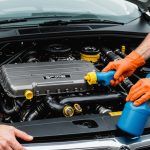Understanding Road Noise
Navigating the complexities of road noise types is crucial for enhancing your driving pleasure, especially in the UK where traffic conditions can intensify these disturbances. The main culprits include tyre noise, aerodynamic noise, and powertrain noise. Each source contributes differently, and recognising them helps in devising targeted vehicle noise reduction strategies.
Tyre noise arises when tyres interact with the road surface, particularly on highways. Meanwhile, vehicles travelling at high speeds often experience aerodynamic noise, stemming from air resistance around the bodywork. Lastly, powertrain noise is the result of vibrations and engine functions, often perceived during acceleration or at low speeds.
Also to discover : Navigating the Legal Process: A Comprehensive Guide to Converting Your UK Vehicle from Petrol to Diesel
These sounds collectively diminish vehicle comfort, especially on long drives, by increasing fatigue and reducing communication clarity. Therefore, understanding the type of noise affecting your vehicle becomes imperative. Employing soundproofing basics is a proven way to mitigate these effects. Soundproofing materials like acoustic mats and seals efficiently reduce unwanted noise by creating barriers or absorbing soundwaves.
Ultimately, pinpointing and addressing specific noise sources ensures a more peaceful driving environment. Whether you opt for tyre changes, improve aerodynamics, or upgrade engine insulation, effective strategies exist to enhance both your journey quality and vehicle ambience.
Also to read : Rev up your wardrobe: stylish cars clothes you need now
Aftermarket Solutions for Reducing Road Noise
Reducing road noise can significantly improve the driving experience, and aftermarket products offer several effective solutions. The UK market provides a variety of options, with sound deadening mats and noise insulation kits among the most popular choices.
Sound deadening mats are designed to absorb sound vibrations, typically made of dense materials like butyl, rubber, or foam. They are applied directly to vehicle surfaces like floors, doors, and roofs to reduce vibrations that cause noise. Their ease of installation and versatility make them a practical option for many vehicle owners.
On the other hand, noise insulation kits offer a comprehensive approach by including various materials tailored to fit specific parts of the vehicle. These kits often encompass a combination of foam panels, thick liners, and sealing strips, targeting multiple noise entry points for a holistic noise reduction strategy.
To decide between these options, consider the areas in your vehicle that need the most improvement. Sound deadening mats are an excellent choice for those seeking a straightforward, DIY project focusing on specific areas. Noise insulation kits may be more suited for those interested in a more thorough noise reduction across the vehicle, often requiring more extensive installation efforts.
Installation Tips for Noise Reduction Solutions
Installing noise reduction solutions can significantly enhance your vehicle’s comfort. Let’s dive into how you can do this effectively.
Preparing Your Vehicle for Installation
Before you start the installation process, ensure your vehicle is ready. Clean the interior surfaces thoroughly to promote adhesion. Organise your materials from your noise reduction kit, such as soundproof mats, adhesive layers, and tools. Taking these initial steps will ease your journey into achieving a quieter ride. A detailed installation guide can also be valuable, whether opting for a DIY method or involving a professional.
Step-by-Step Installation Process
For those interested in DIY noise reduction, follow these steps:
- Identify areas to treat, such as the doors, floor, and roof.
- Measure and cut the noise reduction materials to fit these areas precisely.
- Carefully apply the adhesive-backed materials, ensuring there are no air bubbles.
- Smooth out each layer with a roller for maximum effectiveness.
- Reassemble vehicle panels securely.
Each step is crucial for a successful installation and optimising noise control.
Common Mistakes to Avoid
Avoid these common pitfalls during the installation:
- Skipping surface cleaning can lead to poor adhesion.
- Incorrectly cutting materials wastes resources and reduces effectiveness.
- Rushing the process might result in gaps, leading to unwanted noise leakage.
By following these steps and recommendations, you can achieve a significant reduction in vehicle noise efficiently.
Product Recommendations for Noise Reduction
When it comes to the best soundproofing products, it’s essential to consider their effectiveness, especially in UK vehicle soundproofing projects. Reviews of noise reduction products highlight several recommendations based on user experiences and expert evaluations.
For car owners looking to reduce road noise, products like Dynamat and HushMat are frequently recommended. These brands have built a strong reputation in the UK for their innovative materials and ease of installation. Dynamat, for instance, offers various options suitable for different vehicle types, from compact cars to larger SUVs, making it a versatile choice for many.
Budget considerations are also crucial. For those seeking cost-effective solutions without compromising quality, Silent Coat offers competitive pricing and effective noise reduction capabilities. This brand has become a favourite among budget-conscious drivers in the UK.
When selecting a product, it’s important to match the soundproofing material with your specific needs, whether it’s targeting engine noise, tyre vibrations, or general vehicle acoustics. Brands that specialize in automotive soundproofing often provide a range of products, ensuring there is something suitable for every vehicle type and budget. Always read detailed reviews of noise reduction products to make an informed decision about what’s best for your vehicle.
Cost Considerations for Aftermarket Noise Reduction
When considering noise reduction costs, it’s essential to understand the potential expenses associated with various noise reduction solutions. These can range from simple, affordable options to more comprehensive and costlier soundproofing projects.
-
Budget for soundproofing requires planning. Basic solutions, such as weather stripping or door sweeps, are inexpensive. But for more extensive soundproofing tasks, like installing acoustic panels or specialised windows, you’ll need a larger budget.
-
Value of soundproofing solutions varies significantly. Investing in high-quality aftermarket products can offer more flexibility and may provide superior performance than some factory options. Although initial costs might be higher for aftermarket solutions, the added benefit is customisation tailored to specific needs and environments.
-
Financial aspects of noise reduction aren’t just about upfront costs. Consider the long-term effectiveness. Some solutions may have recurring costs or require replacement over time. Evaluate the expected lifespan and maintenance costs of different soundproofing products to ensure a wise financial decision. In the end, balancing cost with quality and longevity is key to achieving satisfying noise reduction without overspending.
Understanding these nuances helps make an informed choice that aligns with your financial and acoustic needs.
Case Studies and Testimonials from UK Vehicle Owners
Real-life testimonials from UK vehicle owners provide insights into the effectiveness of various road noise reduction strategies. One owner shared their journey of using high-quality soundproofing materials in their car doors, which significantly reduced unwanted noise. They highlighted the importance of choosing the right materials and their impact on overall driving comfort.
Case studies from different regions of the UK further illustrate diverse approaches to noise reduction. In one instance, an individual in London opted for acoustic glass, which not only reduced noise but also enhanced vehicle insulation. Meanwhile, a family in Manchester focused on wheel well insulation to tackle road noise from rougher surfaces.
User experiences consistently mention the importance of proper installation. A testimonial from a Bristol vehicle owner emphasized checking for gaps and ensuring adhesive materials are securely placed. This user gained remarkable results by meticulously following installation guides.
Lessons learned from these endeavours underscore the value of professional advice. Vehicle owners who consulted specialists reported more efficient noise reduction and better long-term outcomes. Key tips from users include starting with the most affected noise areas, such as doors and floors, and gradually moving to other solutions to optimise the overall effectiveness.
Conclusion and Next Steps
Embarking on the journey of noise reduction is not just about immediate comfort but also about enhancing your vehicle’s longevity and value. In this guide, we explored various noise reduction strategies focusing on practical solutions that can be undertaken at home or with professional assistance.
Begin by creating a summary of noise reduction strategies to identify which options align with your specific vehicle needs and lifestyle. Consider starting with simple insulating techniques around doors and windows or moving up to more comprehensive soundproofing projects.
When moving forward with noise reduction, it’s crucial to evaluate what’s practical for you. Isolating engine noise might be the first step, followed by dampening vibrations through advanced materials.
As you contemplate the next steps, assess your vehicle’s current noise levels. Listen carefully while driving; the areas generating the most sound may benefit from targeted strategies. Remember, both simple and complex solutions can significantly reduce noise when chosen wisely.
For further guidance, seek professional assistance by consulting experts who offer tailored advice for your vehicle’s specific needs. Explore reputable online resources, vehicle forums, or manufacturer support pages to expand your understanding and confidence in implementing these strategies. Embrace the journey toward a quieter and more enjoyable driving experience.
Understanding Road Noise and Its Impact
Road noise refers to the sounds generated from the interaction between a vehicle and the road surface, supplemented by airborne noise from traffic. Predominantly, this noise emerges from tyre tread patterns, engine operations, and wind turbulence. Understanding these sources is crucial for distinguishing them from mechanical problems and addressing them effectively.
The impact of road noise significantly affects the driving experience and overall vehicle comfort. Excessive noise can lead to driver fatigue, distractions, and increased stress levels. This not only diminishes the enjoyment of driving but can also compromise safety on long journeys or in heavy traffic conditions. Hence, attention to this aspect proves invaluable for both manufacturers and vehicle owners aiming for optimal comfort.
In a bid to mitigate these effects, sound insulation plays a pivotal role. Effective soundproofing materials like acoustic glass or specialised foams are often used to dampen unwanted noise. These materials are integrated into body panels, floors, and cabin interiors. By blocking or absorbing road noise, sound insulation enhances the driving experience and contributes to the vehicle’s perceived quality. As a result, incorporating efficient soundproofing solutions is deemed essential for improving vehicle performance and comfort.
Overview of Aftermarket Solutions
In the realm of aftermarket soundproofing, a variety of options exist to enhance your vehicle’s acoustics. These materials are specifically designed to offer significant noise reduction beyond what factory-installed solutions typically provide. The main types include foam barriers, fibrous sheets, and damping mats. Each type serves a distinct purpose, such as absorbing sound, blocking noise transfer, or reducing vibrations, ensuring a quieter ride.
Choosing aftermarket soundproofing products presents considerable advantages over factory-installed options. Primarily, they allow for greater flexibility in customisation and are typically more effective in attenuating noise levels. Adding soundproofing upgrades can improve your driving experience by minimising road noise, engine hum, and other external sounds that penetrate the cabin.
The market in the UK is replete with reputable brands offering top-of-the-line vehicle upgrades. Companies like Dynamat, Silent Coat, and Noico are renowned for their high-quality products that consistently deliver excellent noise reduction results. These brands provide a range of solutions to suit different vehicle models and user preferences. Selecting the right combination of aftermarket soundproofing materials and trusted brands can lead to a significant improvement in vehicle comfort, making your journeys more enjoyable and focused on the road ahead.
Detailed Comparison of Soundproofing Materials
Understanding the variety of soundproofing materials is crucial for evaluating their effectiveness. Each material offers unique benefits, impacting both cost and performance.
Comparative Analysis of Foam vs. Mass Loaded Vinyl
When comparing foam to mass loaded vinyl (MLV), effectiveness is key. Foam, while lightweight and cost-effective, is best suited for absorbing sound waves, making it great for reducing echo and reverberation in small spaces. However, when it comes to blocking sound, MLV triumphs due to its dense composition which effectively stops noise transmission, making it ideal for more demanding applications.
Benefits of Heavyweight Mats and Sound Deadening Sprays
Heavyweight mats and sound deadening sprays offer practical soundproofing solutions. Mats, being robust and durable, are excellent for large areas where reducing road noise is critical. Conversely, sound deadening sprays allow for precision application, ideal for targeting specific noise-prone areas, though they may require more frequent application.
Performance of Automotive Soundproofing Mats
Automotive soundproofing mats are highly effective in reducing road noise, offering substantial acoustic improvement within vehicles. These mats, while more expensive initially, offer long-term savings by enhancing vehicle comfort. Users have praised their durability and ease of installation, making them a popular choice in noise reduction projects.
Step-by-Step Installation Guides
Considering vehicle maintenance along with DIY soundproofing can significantly enhance your driving experience. Installing sound deadening mats is a popular installation process that can be effectively managed with the right guidance.
Applying Sound Deadening Mats
To begin, clean the area where you intend to apply the mats, ensuring no dirt or oil remains. Cut the mats to fit the panels accurately, using a utility knife. Peel the adhesive backing and press the mat firmly onto the surface, working from one end to the other to avoid air bubbles.
Treating Door Panels and Trunks
For door panels, remove the panels using a trim removal tool. Identify the areas with minimal noise absorption and line with the mats. In trunks, removing the interior lining will allow for more direct application. This enhances the effectiveness of sound insulation across your vehicle.
Essential Tools and Safety Precautions
Key tools include a roller to smooth out the mats, a utility knife for cutting, and trim removal tools for door panels. Safety precautions are also crucial; wear gloves to protect your hands and ensure proper ventilation if working in a confined space.
Approaching this project methodically ensures optimal results, leading to quieter, more enjoyable travel.
Case Studies: Success Stories from UK Vehicle Owners
Delve into fascinating user testimonials highlighting the transformative effect of vehicle noise reduction. These case studies showcase remarkable changes, offering inspiration for those seeking quieter rides.
Case Study 1: Family Sedan
A UK family faced persistent cabin noise disrupting conversations. Implementing soundproofing solutions resulted in a marked reduction in noise levels, significantly enhancing their driving experience. Feedback from this family sedan owner underscores effective noise reduction, achieved with reasonable costs and time investments.
Case Study 2: Sports Car
Despite its sleek design and impressive engine, a sports car enthusiast found engine noise intrusive. Employing advanced soundproofing techniques remarkably muted unwanted sounds, allowing for undisturbed enjoyment of the vehicle’s dynamic performance. This case study illuminates the profound impact noise reduction can have, even in high-performance vehicles.
Case Study 3: Commercial Vehicle
A delivery company sought better conditions for drivers dealing with incessant road noise in commercial vehicles. Through strategic modifications, they achieved a quieter fleet, creating a more comfortable work environment. The extent of the noise reduction has been pivotal, enhancing driver satisfaction and productivity while maintaining budgetary constraints.
These insightful analyses demonstrate how effective noise reduction, backed by realistic costs, transforms diverse vehicles—highlighting the broad applicability of soundproofing solutions.
Where to Purchase Aftermarket Solutions in the UK
In the UK, aftermarket solutions such as soundproofing products can be found both through physical stores and online platforms. When considering options, one effective approach is to explore local suppliers and well-established UK retailers, who often provide specialised knowledge and customer service.
Physical Stores
You may find soundproofing products in hardware stores like B&Q or Wickes. These retailers often provide a range of materials suited for different projects, offering tangible benefits such as immediate purchase and personalised advice. Visiting these stores allows you to physically inspect the products, ensuring their quality aligns with your expectations.
Online Shopping
Online shopping platforms offer convenience and a broader selection. Websites such as Amazon and Soundproofing Store provide a comprehensive range of options. It’s crucial to compare prices across various sites to find the best deal. Look for reviews and detailed product descriptions to ensure quality and suitability.
Local Suppliers
Engaging with local suppliers can offer tailored solutions and unique materials that mass market retailers may not provide. These suppliers often know the local regulations and building requirements, further ensuring your project’s success.
Tips
- Compare prices across multiple platforms for the best deal.
- Check customer reviews to gauge product quality.
- Ensure that any product meets UK standards for effectiveness and safety.
Costs Associated with Soundproofing Your Vehicle
When diving into the realm of soundproofing costs, it’s essential to break down the expenses involved. Materials for soundproofing upgrades may vary widely in price, with options like mass-loaded vinyl, foam insulation, and sound-deadening mats, each carrying unique cost implications. On average, expect materials to cost anywhere from £50 to £150 per door. Financial considerations also include labour costs if you choose professional installation, which might add an additional £300 to £600 to your total.
Budgeting for upgrades requires strategic planning. Evaluate which areas of your vehicle need the most attention; prioritising can help control costs. Consider tackling one section at a time if you’re constrained by budget limitations. Creating a detailed estimate of potential expenditures before beginning the project can prevent unexpected financial strain.
Moreover, there is often a return on investment when it comes to soundproofing. Enhanced acoustic comfort can vastly improve your driving experience and potentially increase your vehicle’s resale value. Future buyers often appreciate quieter cabin spaces, thus raising the desirability of the vehicle in the market. Investing in soundproofing isn’t just about immediate gratification—it’s about long-term gains, balancing comfort with value preservation.










